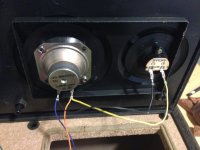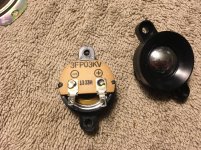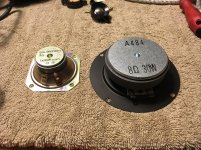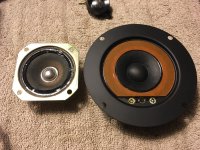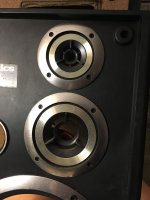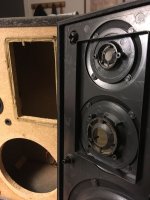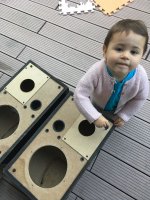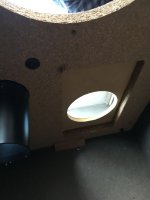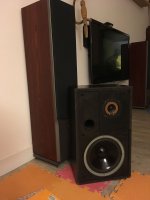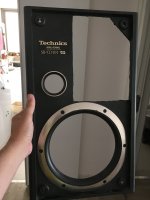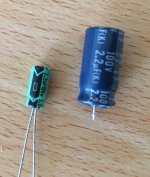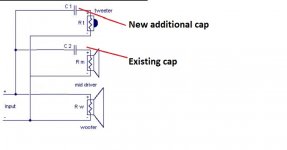Hi diyers! This is my first post I need some help.
I have a couple of Technics sb-cd101 loudspeakers that were from my father.
The woofer and tweeter seems ok but the midrange makes no sound.
I opened one and saw that the crossover resistor is like burned. Same the other.
I connected the midrange to an amp and it didn’t make sound.
I will to replace the resistor with a new one and get a new driver.
The thing is that I don’t know what driver I need because total newbee here. No loudspeaker building knowledge.
Can someone in this wonderful forum help me get the right one?
I don’t need audiophile quality or anything only restore the sound.
I attached the specs I could get.
Thanks!
I have a couple of Technics sb-cd101 loudspeakers that were from my father.
The woofer and tweeter seems ok but the midrange makes no sound.
I opened one and saw that the crossover resistor is like burned. Same the other.
I connected the midrange to an amp and it didn’t make sound.
I will to replace the resistor with a new one and get a new driver.
The thing is that I don’t know what driver I need because total newbee here. No loudspeaker building knowledge.
Can someone in this wonderful forum help me get the right one?
I don’t need audiophile quality or anything only restore the sound.
I attached the specs I could get.
Thanks!
Attachments
-
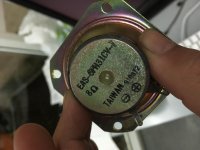 A9AA1373-E4B9-4285-B0BC-3F4794E4DB66.jpg925.7 KB · Views: 383
A9AA1373-E4B9-4285-B0BC-3F4794E4DB66.jpg925.7 KB · Views: 383 -
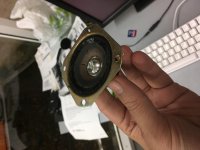 C64E6240-7D7C-46AB-8019-336AAB71C764.jpg792.3 KB · Views: 380
C64E6240-7D7C-46AB-8019-336AAB71C764.jpg792.3 KB · Views: 380 -
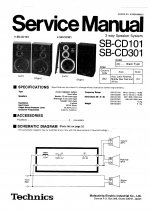 9443B30E-C7F3-458D-A696-013065268FE1.jpg548.2 KB · Views: 495
9443B30E-C7F3-458D-A696-013065268FE1.jpg548.2 KB · Views: 495 -
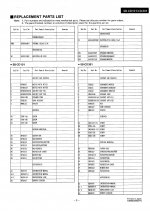 A1855EA1-2DC3-47AE-8556-FD74B930DCD5.jpg665 KB · Views: 357
A1855EA1-2DC3-47AE-8556-FD74B930DCD5.jpg665 KB · Views: 357 -
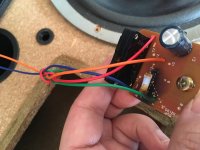 883D22A1-5E95-4246-AFB4-CCC3B2CC71FE.jpg772.1 KB · Views: 348
883D22A1-5E95-4246-AFB4-CCC3B2CC71FE.jpg772.1 KB · Views: 348
Hi and welcome to diyaudio! If you dont get much of a response here, in introductions. Try posting over in tbe multiway forum 🙂
Tony.
Tony.
I'd be inclined to replace it with a full range driver (in both speakers) such as the Peerless TC9 or Visaton FRS8. You'll need to tweak the value of the resistor to get the level right. I suspect your biggest problem will be finding out what's available to you locally.
FWIW, drivers with a part code starting with 'EAS-' are made by Matsushita, very hard to get replacements unless out of old loudspeakers
FWIW, drivers with a part code starting with 'EAS-' are made by Matsushita, very hard to get replacements unless out of old loudspeakers
Looking at the provided crossover diagram, it appears that both tweeter and mid are connected to the same crossover elements. And while this is strange, it leaves no options in tuning the mid separately from the tweeter, something you surely need to do in the event your replacement is different from the original.
Without measurement equipment I won't do anything, we don't even know the crossover frequencies, the only sensible option would be to find an donor sb-cd101 or cd301 speaker in which the mid works.
Good luck.
Ralf
Without measurement equipment I won't do anything, we don't even know the crossover frequencies, the only sensible option would be to find an donor sb-cd101 or cd301 speaker in which the mid works.
Good luck.
Ralf
undress, try to find a cone tweeter of similar diameter, 8 ohm nominal. How much does the surround of the cone measure?
First this is a cheap speaker, and I would not recommend spending much money to get them working. The crossover frequency to the midrange is 4000hz, which makes it more a tweeter than a midrange. The single capacitor of 2.2 uf in line with the midrange cuts the lower frequencies very gradually from about 8000 hz. This means the speaker is under stress trying to play lower frequencies, hence the speaker blew and the resistor fried trying to dissipate the heat while playing loud. The speaker is a sealed back so you need to find an equivalent dimensioned 8ohm cone tweeter, sensitivity around 89db, 30 watts with a sealed back. Consider the GRS Phenolic Ring Tweeter at Parts Express if it fits. Adjust the value of the resistor until you are happy with the sound.
PeterMcK:
A full range driver sounds like a great idea and disconnecting the actual tweeters. They looks like piezo buzzer very low quality tweeters. Locally I don't think I can get any of the drivers you recommend but I can buy them online. By the way I am Uruguayan. Hope my english is good enough.
Those drivers are bigger than the actual hole but I think I can figure out how to adapt them. Cheap enough
giralfino:
I looked for original replacement drivers but can't find one. The midrange and tweeter are indeed connected to the same cables (photo attached). I think it's a good idea to eliminate that tweeter to deal with only one crossover between bass driver and the new one. I don't have any measuring equipment.
Lojzek: it's a 2 inches cone. 2.55 in from mounting hole to hole measured diagonally. The frame is almost a square with sides of 2.44 inches.
pop4richard: YES it's a crappy speaker I don't want to expend much money. That driver is 2 inches. Perfect. I think I can adapt it to the actual holes. They are not that cheap 🙁 but ok
I don't know much but I think is most adequate than the others drivers because of the sensitivity and sealed back.
Didn't understand very well your crossover failure theory. Do you think It will happen again with the new driver?
And the important question: Do you think I can fix it without measuring equipment? Can you elaborate more about the resistor options and what I must look for?
Thank all of you!
A full range driver sounds like a great idea and disconnecting the actual tweeters. They looks like piezo buzzer very low quality tweeters. Locally I don't think I can get any of the drivers you recommend but I can buy them online. By the way I am Uruguayan. Hope my english is good enough.
Those drivers are bigger than the actual hole but I think I can figure out how to adapt them. Cheap enough
giralfino:
I looked for original replacement drivers but can't find one. The midrange and tweeter are indeed connected to the same cables (photo attached). I think it's a good idea to eliminate that tweeter to deal with only one crossover between bass driver and the new one. I don't have any measuring equipment.
Lojzek: it's a 2 inches cone. 2.55 in from mounting hole to hole measured diagonally. The frame is almost a square with sides of 2.44 inches.
pop4richard: YES it's a crappy speaker I don't want to expend much money. That driver is 2 inches. Perfect. I think I can adapt it to the actual holes. They are not that cheap 🙁 but ok
I don't know much but I think is most adequate than the others drivers because of the sensitivity and sealed back.
Didn't understand very well your crossover failure theory. Do you think It will happen again with the new driver?
And the important question: Do you think I can fix it without measuring equipment? Can you elaborate more about the resistor options and what I must look for?
Thank all of you!
Attachments
Richard is saying that the capacitor only allows the higher frequencies to pass.
The resistor is a 39 ohm 2 watt part and so you can tweak the value a little to alter the intensity of sound from the mid and tweeter. Going higher in value is safe, going significantly lower would run these two drivers harder.
Its really a case of adjusting by ear to get the sound you like and there are no guarantees it will be great anyway. Don't expect to much and you might be pleasantly surprised 🙂
The speakers must have been driven very hard to burn the resistor out or have they been used on diy amplifiers that might have had stability problems ? That could also cause it.
For normal listening you are unlikely to burn out replacements.
The resistor is a 39 ohm 2 watt part and so you can tweak the value a little to alter the intensity of sound from the mid and tweeter. Going higher in value is safe, going significantly lower would run these two drivers harder.
Its really a case of adjusting by ear to get the sound you like and there are no guarantees it will be great anyway. Don't expect to much and you might be pleasantly surprised 🙂
The speakers must have been driven very hard to burn the resistor out or have they been used on diy amplifiers that might have had stability problems ? That could also cause it.
For normal listening you are unlikely to burn out replacements.
Have a look at Monacor HT22/8, Visaton TW70-8, Visaton TW6 NG-8. That GRS is a fine replacement.
Check this out.
Cone Tweeter
Check this out.
Cone Tweeter
Last edited:
Hi Mooly. Thank you for the response.
I got it!
If I don't get more recommendations soon I will buy those phenolic rings and try them.
The speakers where used with a technics SU-X102 that had issues and didn't turn on sometimes.
Reading the amp hifiengine page people said that sometimes some regularots becomes loose so I opened it and voila! loose soldering. I re-did the soldering and It turn on again. I didn't test the sound yet. I think that was the issue that burned the speakers.
I got it!
If I don't get more recommendations soon I will buy those phenolic rings and try them.
The speakers where used with a technics SU-X102 that had issues and didn't turn on sometimes.
Reading the amp hifiengine page people said that sometimes some regularots becomes loose so I opened it and voila! loose soldering. I re-did the soldering and It turn on again. I didn't test the sound yet. I think that was the issue that burned the speakers.
Yes, an amplifier with a DC offset (that means high DC voltage on the speaker output) would burn the resistors out but it would also burn the woofers out.
You need to be sure they are OK before spending money on these. If they play and sound OK and are not distorted (the coil rubbing on the magnet internally) then they should be fine.
If you gently press the woofer cone in and out then it should be free and not 'grating'. Never try that on the smaller drivers though.
Do check them before proceeding.
You need to be sure they are OK before spending money on these. If they play and sound OK and are not distorted (the coil rubbing on the magnet internally) then they should be fine.
If you gently press the woofer cone in and out then it should be free and not 'grating'. Never try that on the smaller drivers though.
Do check them before proceeding.
Hi. I finally received the tweeters! It took a long time to arrive here in Uruguay.
I want to make an update of this "restoration" for someone to take advantage of my experience. In the pics you can see the differences of the phenolic tweeter and the previous "midrange". The new one seems to be the same cone size but the magnet and all metal parts are huge in comparison. I added pictures of the previous "tweeter"that I will take out.
I want to make an update of this "restoration" for someone to take advantage of my experience. In the pics you can see the differences of the phenolic tweeter and the previous "midrange". The new one seems to be the same cone size but the magnet and all metal parts are huge in comparison. I added pictures of the previous "tweeter"that I will take out.
Attachments
Here you can see that the previous drivers were mounted in the plastic front grille. Not a very good idea. The holes didn't match either so I had to do some surgery. First I cover the hole in the box with some MDF and drill a round hole for the driver. Now the grille is just a grille. I didn't measure well the hole and turn out different height for each speaker. You can see that in the pic were my daughter is "helping" me. I think It will be ok. Then I painted all with black to have a nice background to the speaker fabric. Finally I trimmed the grilles with a dremel.
Attachments
 that looks pretty good to me.
that looks pretty good to me. Just to be sure... you are replacing what looks to be a piezo type tweeter with a conventional type. If so then I think you may need to wire the tweeter separately to the main input but through a suitable small capacitor.
Otherwise the tweeter load will shunt the midrange driver and also the tweeter will be fed more signal than it can handle.
We need to be sure on this 🙂
That model number certainly comes up as a piezo Mooly, and it would explain the apparent lack of magnet. So yes a cap in series seems like a must.
Piezo's tend to have quite high cutoff frequencies, not uncommon for 4-5Khz so a cap around the 5uF mark might be a good starting point(that's based on an impedance of 8 ohms, since I don't have an impedance curve to go off).
Tony.
Piezo's tend to have quite high cutoff frequencies, not uncommon for 4-5Khz so a cap around the 5uF mark might be a good starting point(that's based on an impedance of 8 ohms, since I don't have an impedance curve to go off).
Tony.
Last edited:
Hi guys. I rebuild the crossover to the same specs you can see in the first page. The cap is 2.2uF and the one that I could get is much smaller than the original and does have the black stripe polarity thing that the old one hadn't. I hope that the new one is ok.
The resistor is the same 39ohm 2w. I didn't take photos of the soldering job 🙁
Now. I connected it and it sounds "good". I think some tweaking those values is the next step. I think I can raise the gain in that tweeter.
Can you recommend some resistor value? I need higher or lower value?
Tks
The resistor is the same 39ohm 2w. I didn't take photos of the soldering job 🙁
Now. I connected it and it sounds "good". I think some tweaking those values is the next step. I think I can raise the gain in that tweeter.
Can you recommend some resistor value? I need higher or lower value?
Tks
Attachments
The new cap you show is 'polarised', it has polarity markings.
The old one is marked 'BP' which means 'Bipolar' or non polarised.
So its not really suitable I'm afraid 🙁
You can make a 'BP' type from two series connected polarised caps by connecting them in series and connecting either the plus of each together or the minus of each together. It doesn;t matter which. You would need two 4.7uF caps to make an equivalent 2.35uF BP cap.
Have you understood what we mentioned above about the new tweeter and perhaps adding a separate cap to feed it ?
The old one is marked 'BP' which means 'Bipolar' or non polarised.
So its not really suitable I'm afraid 🙁
You can make a 'BP' type from two series connected polarised caps by connecting them in series and connecting either the plus of each together or the minus of each together. It doesn;t matter which. You would need two 4.7uF caps to make an equivalent 2.35uF BP cap.
Have you understood what we mentioned above about the new tweeter and perhaps adding a separate cap to feed it ?
Ok thanks! I will see what I can do with that BP Cap.
But I think I don't understand the extra Cap suggestion completely.
The midrange and piezo tweeter were originally in parallel connected to the same crossover elements and the woofer had no filters at all. As pop4richard said that the midrange was more like a tweeter I thought It was a good idea to eliminate both and replace them with his suggestion. Now I have a 2way configuration so I don't understand your drawing.
I thank you again for taking your time to help me.
But I think I don't understand the extra Cap suggestion completely.
The midrange and piezo tweeter were originally in parallel connected to the same crossover elements and the woofer had no filters at all. As pop4richard said that the midrange was more like a tweeter I thought It was a good idea to eliminate both and replace them with his suggestion. Now I have a 2way configuration so I don't understand your drawing.
I thank you again for taking your time to help me.
- Status
- Not open for further replies.
- Home
- Loudspeakers
- Multi-Way
- Need help replacing midrange driver
